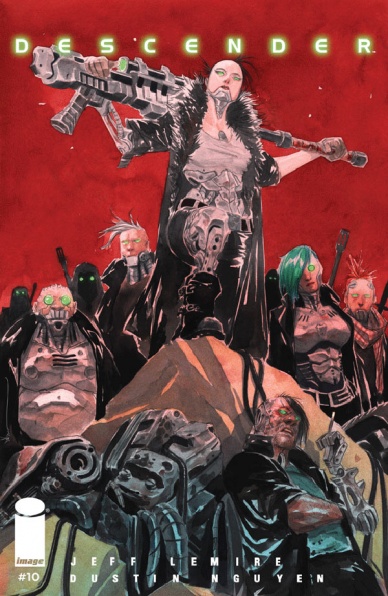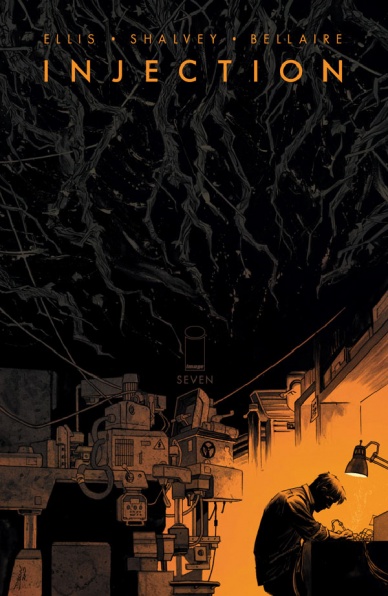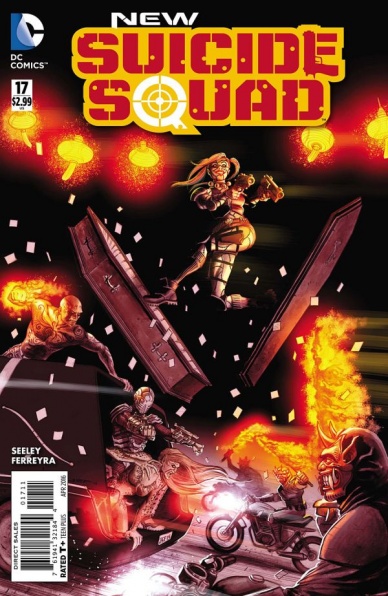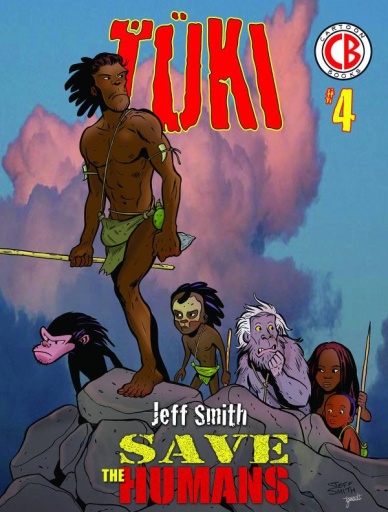There is a lot to cover on Wednesdays. We should know, as collectively, we read an insane amount of comics. Even with a large review staff, it’s hard to get to everything. With that in mind, we’re back with Wrapping Wednesday, where we look at some of the books we missed in what was another great week of comics.
Let’s get this party started.

Descender #10
Written by Jeff Lemire
Illustrated by Dustin Nguyen
Review by Ken Godberson III
“Descender” continues to chug along on its story just fine, even with this… let’s face it… “Middle of the Arc” issue, which deals with moving along several plot lines at once, specifically TIM-21’s and Andy’s. This issue also sees the introduction of a new faction. We’ve had organics. We’ve had robots. Now we have those in between. The cyborgs. Just the brief tidbits we get here are interesting enough to want to see more (also, we have the damning knowledge that, even in the far future microtransactions will plague video games), but I am more and more beginning to feel that this book is more of a trade-wait book than something one can follow in singles. Nothing in this issue was bad, but it does feel a wee-bit decompressed to the breaking point.
As always, Dustin Nguyen’s watercolor work and character designs continue to shine. He gets to range from some more colorful and fantastic when TIMs 21 & 22 are playing a video game to garish designs of the cyborgs. To put simply: There is no one else that could draw this book.
Final Verdict: 6.2- A decent, but very decompressed issue. I recommend potentially switching to trade-wait for this one.

“Injection” #7
Written by Warren Ellis
Illustrated by Declan Shalvey
Reviewed by Stephenson Ardern-Sodje
Man, this comic is ridiculous, And I love it for it.
Seriously, Injection is probably one of the books I’m understanding least and enjoying the most at the moment. Its purposeful narrative insouciance means that, seven issues in, we’re still unsure exactly what the aforementioned ‘injection’ is, or what it does, or why it’s doing it, but Ellis’ metered drip-feed of information means that every issue feels as though it’s flowing towards a looping, long-form conclusion that is worth waiting for.
Meanwhile, Ellis is managing some seriously weird world-building, and having an awful lot of fun doing it. Each issue so far has focussed on a member of the disbanded Injection research team and #7 is the second one to focus on private investigator and modern Holmesian analogue Vivek Headland. Vivek has been hired to track down the ghost of a millionaire’s recently deceased wife, and his search leads him to downtown New York by way of a possibly cannibalistic deli, in search of a highly trained cult member-turned-assassin. If it sounds bonkers, that’s only because it is, but brilliantly so. Ellis has managed to inject (sorry) each new character’s individual issues with a different, vibrant tone, and Vivek’s specific blend of sociopathic detective adventure might be my favourite yet.
Issue #7 is a direct lead on from the previous issue, and issue #6 definitely had a lot more in the way of action. Shalvey’s work in this issue is more facially focussed than this book usually gets, with the detective element giving him the chance to work on a lot more slow, nuanced conversations than in previous issues. His ability to convey the, often strained, relationships between Vivek and the rest of the CCCU (ex Injection staffers) through well-paced, almost televisual conversational pieces grounds the more ridiculous elements of this narrative and brings a level of visual humour to this book that helps keep the tone from feeling too earnest.
This issue is solid evidence of Ellis and Shalvey’s ability to play with the genre of their book from issue to issue without it detracting from the strange, techno-paranormal Gothicism of their overall tone. “injection” is a great example of an ensemble cast story, made even better by Ellis’ masterful management of the interpersonal relationships of the group. Some of them are friends, some are family, some can’t seem to stand one another, but all of them bring something unique to the table, both in terms of in-world skills, and in terms of how their story is told.
Continued belowFinal Verdict: 7.6 – Another great entry into an already stellar series. If a sharp, smart, paranormal thriller sounds up your street then you should already be reading this.

Interceptor #2
Written by Donny Cates
Illustrated by Dylan Burnett
Reviewed by Jess Camacho
If there was ever an ongoing series that captures what Heavy Metal is as a brand, it’s “Interceptor”. “Interceptor” #2 picks up with Weep and Poli in custody of the vampires. Together, they have to bust out of this prison and while they are trying, Weep’s family is coming to get her. “Interceptor” #2 becomes a big, action extravaganza full of blood, guts and mayhem. It’s easy for something like this to fall apart but Cates is so good at writing dialogue that it should almost be a crime. Each character, even the ones who are there just to get stabbed, have bite. This deals with a heavy war that will determine the fate of humanity but like “The Ghost Fleet”, Cates doesn’t let himself get bogged down by the drama. The stakes are still high in this issue but there’s great character development and genuine laughs throughout the entire issue.
Dylan Burnett’s art is the exact kind of crazy this story needs. His art is big, dynamic and has just the right amount of visual comedy without losing any of that 90s action movie vibe the writing calls for. Burnett’s design of Earth as it stands with the vampires having taken over is great. It absolutely looks like somewhere regular humans can’t live. It captures the perfect amount of destruction and is a unique feeling wasteland. The character designs are really fun as they all sort of have this sense of style that reflects their personalities in a subtle way. Burnett’s colors are neon deliciousness and I’m blown away by the way neon pink is used.
Final Verdict: 8.4 – “Interceptor” is bonkers in all the best ways.

New Suicide Squad #17
Written by Tim Seeley
Illustrated by Juan Ferreyra
Reviewed by Brian Salvatore
For what seems like the 5th time since the New 52 started, the Suicide Squad is getting a slight reboot. This time, DC enlisted two of their secret weapons, Tim Seeley and Juan Ferreyra to steer the ship, and so far, they’re doing a fine job. This issue creates a Canadian government issued super team that is used as a MacGuffin to retell (again) the basic Suicide Squad story.
Why this reboot succeeds while so many others have faltered is that Seeley strips the team down, both in size and in concept. This is a very straightforward issue that introduces just a few essential members, puts them in an easy to understand situation, and executes it nicely. Ferreyra is one of my favorite artists working today, and his mix of realism and the grotesque is a perfect fit for this book. He doesn’t overly sexualize Harley Quinn like so many do, nor does Seeley make the book so dark that he removes her humor. I generally abhor the character, but this issue makes a case for a well balanced Harley.
It doesn’t hurt that the issue ends of a cliffhanger, which does a lot to whitewash some of the other issues with the book – namely, the shoehorning in of El Diablo to coincide with the film, or the plot being just a little too neat. Overall, this is right alongside Ales Kot’s aborted reboot in terms of accessibility and intrigue for a property that used to be synonymous with both.
Final Verdict: 7.9 – A solid entry point for new fans, and a rewarding read for old ones.

Tüki Save the Humans #4
Written by Jeff Smith
Illustrated by Jeff Smith and Tom Gaadt
Reviewed by Matthew Garcia
Jeff Smith knows how to put together an issue of a comic. The dude continually provides some of the most accomplished and effective cartooning in the medium, and he makes it seem so effortless and simple. “Tüki Save the Humans” #4 is a smaller comic, not quite as expansive or epic as some of the previous issues in the series: it only has one real location and centers around the characters all trying to convince Tüki to get them out of the prehistoric Africa, yet nonetheless provides a strong and compelling narrative.
The book still retains its horizontal format, but Smith decided to print it like a normal comic, so when you hold the whole spread, it comes off like a glorious Sunday comic. If anything, this format boosts Smith’s sense of timing, since the page has this long flow. He works with colorists Tom Gaadt, and together they make this world feel so large. Gaadt does well in the sanctuary place, giving it this vibrant lusciousness but still conveying that it’s slowly dying out. All in all, this is a great book to look at, and with the adventure starting to really rear up, it looks like it’s only going to get more exciting.
Final Verdict: 9.0 – always great to see the work of a high talent.






